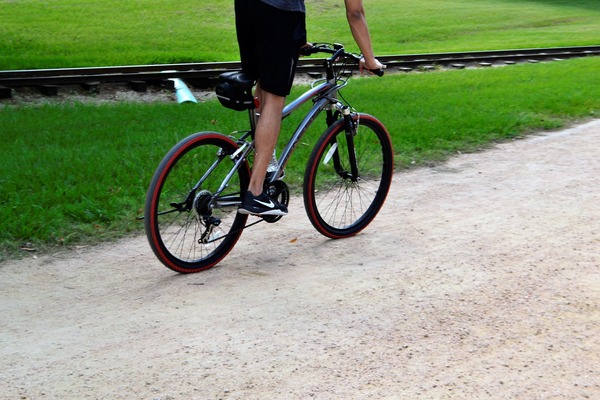If you are researching cyclocross bikes you may be wondering if they even have suspension, or not…
Do cyclocross bikes have suspension?
That is going to be up to you. Generally, cyclocross bikes will not have suspension, but some models DO have this and so it’s something that you would select on purchase. Typically, cyclocross fans will opt for the models without it, but if you want a cyclocross bike with suspension then this is easy to obtain.
The designs that incorporate the suspension are better for a more leisurely ride so that you can go longer distances on your bike in relative comfort and do a little off-roading from time to time.
Is a cyclocross bike good for road riding?

Yes, cyclocross bikes may be used for road riding, but if you are competing then you should know that they are marginally slower. On average, a road bike goes about 34 miles per hour, while a cyclocross is going to travel around 27 to 29 miles per hour.
It’s not an enormous difference, however, and you’ll have the advantage when it comes to off-roading, and so many cyclocross fans are quite happy to make this trade-off. After all, a little less speed, but with the option of better all-terrain negotiation is a concrete perk.
What is the difference between a cyclocross bike and a road bike?
From a practical standpoint, the road bike is going to be faster on the road, as this is what it is optimized for. The frame on the cyclocross bike, as well as its wider tires, allow for easier negotiation of off-road terrain and keep you comfortable in the process.
While you can take a road bike off-road, the cyclocross will have the advantage there, and if you raced the two on a flat road, the road bike is typically only going to be about 5 mph faster – making the cyclocross the more attractive option for many cyclists who like to leave the road from time to time.
Is a cyclocross bike the same as a gravel bike?
No, a gravel bike and a cyclocross bike are both designed differently. The cyclocross, for instance, will allow for a more aggressive riding stance and it has a higher bottom bracket than the gravel bike’s design.
While the gravel bike is better for variable, shifting terrain such as dusty, rocky roads, the cyclocross is suited for many different kinds – roads, mud, gravel, high grasses, and hills – and it will have superior handing in most cases on the widest variations of terrain.
What is the purpose of a cyclocross bike?
Cyclocross was designed by Tour De France riders, with the idea in mind of creating an exercise bike that could be used in-between competitions during the fall and winter to keep in shape. It is marginally slower than a road bike but capable of going off-road and traversing more difficult terrain.
The final design turned out to be quite a lot of fun to ride, and so these bikes have gone from being simply ‘exercise’ bikes to developing a devoted following of their own.
Rather than exercise, they are one of the ‘bikes of choice’ for riding in mud, gravel, trails, and other assorted terrain features, and beloved for their versatility.
What is the point of cyclocross?
Cyclocross bikes are a good ‘all-purpose’ sort of bike that gives riders the option to travel quickly on roads, but also to take their bike to trails and hills, where they are well-equipped by the design to move fast!
Cyclocross bikes work well in gravel, mud, and even snow, and they do this without sacrificing much speed at all on the road. When you consider that a road bike is only about 5 miles per hour faster, then it’s easy to see the point of Cyclocross – they’re versatile and simply good, old-fashioned fun!
Are cyclocross bikes slower than road bikes?
Only marginally, unless the road bike has had a lot of upgrades. The standard road bike is rated for around 34 to 35 miles per hour at a ‘brisk’ pace, while a cyclocross bike is around 27 – 29 miles per hour at the same pacing.
It’s an almost negligible difference when you consider the bike’s off-roading power, and this has made cyclocross bikes understandably quite popular.
Is a cyclocross bike faster than a mountain bike?

Yes, cyclocross bikes are going to be a little faster than mountain bikes, except going downhill. Mountain bikes have heavier frames that are also a bit tougher, so they are maximized for ‘rough and tumble’ descents.
That said, the cyclocross is lighter and quite easy to handle, so except for downhill speed runs, it is usually going to be faster and the nimblest bike of the pair.
The mountain bike, however, is going to be much more robust – they’re quite a bit harder to damage, although unlike cyclocross they will not do well on long stretches of flat road.
Can a cyclocross bike be used for touring?
Yes, a cyclocross bike is quite a comfortable ride for touring if that is what you want to use it for.
While it will be marginally slower than a road bike, unless you’ve got fairly large feet (which could be a problem with the chainstay length on a cyclocross), then touring is certainly going to be an option if you like.
You’ll get excellent handling and if you switch to road tires specifically for the tour, then that might also give you a little edge in speed to compensate for the difference between cyclocross and a standard road bike.
Why do cyclocross bikes have drop bars?
Drop bars are their by-design and they were selected for their ability to gracefully control your bike during long curves and to allow you to hunch down and get aggressive on the straightaways.
They give you a good combination of speed and control that holds firm on the road, as well as on terrain that’s a bit more on the wild side.